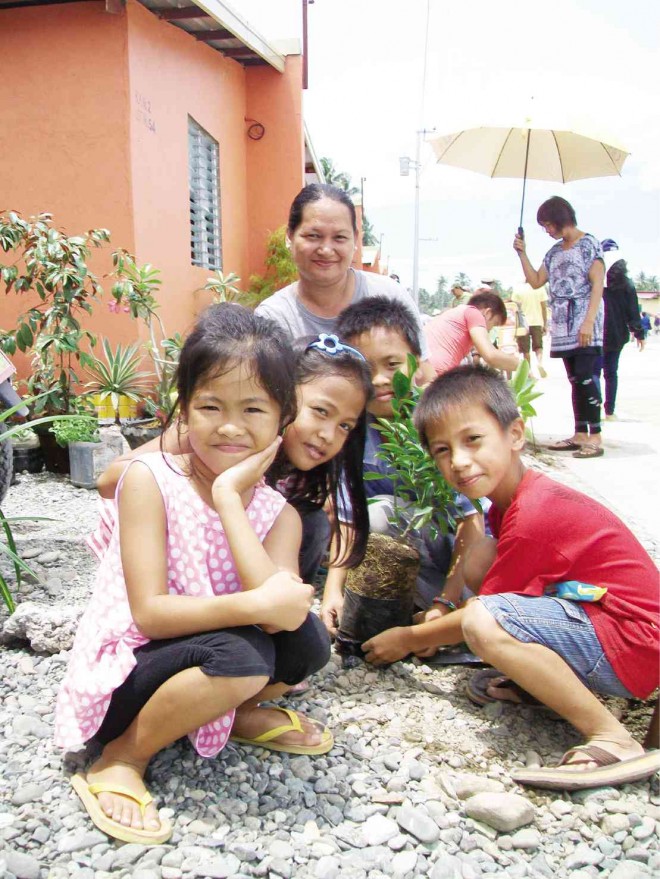
RESIDENTS of new houses in the San Roque resettlement project in New Bataan, Compostela Valley province, pose for a picture after planting calamansi outside their new house. The resettlement project is for survivors of Typhoon “Pablo.” FRINSTON L. LIM
NEW BATAAN, Compostela Valley—Housewife Marilyn Regis was in high spirits as she clasped with both hands a lump of loose earth to cover the calamansi seedling she just planted in front of her new house.
She, her husband and their three children were moving into their new concrete house in a 22-hectare former coconut plantation community in San Roque village here.
“We won’t be living anymore in a hut near a riverbed that swells and threatens us with flooding during heavy rain,” said the 36-year-old mother, who is several months pregnant with her fourth child.
But, as in so many things, nothing is perfect. Regis and other women in this new community for typhoon survivors expressed frustration at the lack of basic utilities in their new homes.
The occupants of the new houses complained of weak water pressure in their faucets. Some said there was no water at all.
“We can’t even have water for our toilets,” said Malyn Natorio, 27, one of the housing project beneficiaries.
“Our neighbors have to walk a considerable distance from here to get water for bathing,” she said.
Residents also complained that they have to cough up as much as P5,000 just to have their homes connected to the power line of the local power utility, Davao del Norte Electric Cooperative (Daneco).
“That’s too expensive for us,” said 24-year-old Kenneth Sembrano, father of a one-and-half-year-old boy. Sembrano works at a mine in Agusan del Sur province.
Late last month, the Regises, Natorios and 202 other families from villages in New Bataan ravaged almost two years ago by Typhoon “Pablo” (international name: Bopha) left their former homes and occupied the government-built houses in San Roque village.
The new community in San Roque is part of the government’s efforts “to protect the people against the [effects] posed by climate change,” said Carolina Angel, southern Mindanao director of the National Housing Authority (NHA).
Angel said the government, through the NHA, would build at least 2,365 houses for New Bataan alone, as part of the rehabilitation and reconstruction efforts for those affected by 2012’s strongest storms.
At the San Roque NHA resettlement site, 128 families from Cabinuangan village have moved in. At least 29 families from Cogonon, 21 families from San Roque and 26 from the communities of Kahayag, Andap and Fatima have also transferred there.
Local authorities have thanked the national government and the NHA for their continued support for the rehabilitation efforts in Compostela Valley province, even as the government continues to grapple with one disaster after another, Supertyphoon “Yolanda” being one of the most recent.
“At least, New Bataan has already started getting back on its feet. We’re grateful (to the NHA) for giving us hope that despite what we have endured, we can still recover,” Mayor Lorenzo Balbin Jr said.
Angel acknowledged that the beneficiaries have to do their share in taking care of their new homes and their new community.
“This is not the end of your troubles. There’s still much to do ahead. We have an obligation to improve [the new] community,” the regional NHA official said.
Josephine Frasco, provincial social welfare chief, said giving houses to those left homeless by the typhoon remained to be a priority.
Aside from the NHA, the Department of Social Welfare and Development (DSWD) is also helping build houses on sites chosen by the survivors themselves and which have been declared safe by the Mines and Geosciences Bureau (MGB) and on areas chosen by the DSWD.
Gov. Arturo “Chiongkee” Uy said 26,000 houses were destroyed in Compostela Valley and had to be replaced, aside from 50,000 houses that needed repairs.
The governor was also profuse in his gratitude to the national government, even thanking President Aquino for constantly asking and monitoring how the government housing projects for Pablo survivors are going.
“He was constantly calling me, asking if [the projects] were on schedule, if the beneficiaries have already transferred to their new homes,” Uy said.
During a speech following the blessing of the new houses, the governor expressed displeasure that the actual houses were not identical with the “model one.”
“When I stepped into the model house, I gushed at how it looked so nice,” Uy said.
“But when I entered the actual homes, I was disappointed. The flooring has no smooth finishing. It was very rough and appeared uneven, and little children might get hurt if they trip on it,” said the governor.
The governor told NHA officials to act on this, warning that he would not accept future turnovers of NHA houses if the problem was not solved.
“I don’t think the contractor will lose much if it does the houses’ flooring better. Our on-site housing projects (funded by the DSWD) are better but cost less,” the governor said, adding that he would be monitoring the construction to see to it that the NHA complies.
Built by CS Garcia Construction, each of the 4-by-5.5-meter houses sits on a 60-square-meter lot. The total house and lot package costs P220,000 each, or about P44 million for units for 204 families.
“The governor was right on that,” said Regis, who has children ages 2, 11 and 14 years old. “The flooring is dangerous to the children. You know, they are fond of running around,” Regis said.
The new homeowners also planted calamansi tree seedlings, which were given by 1st District Rep. Maria Carmen Zamora, outside their homes.
For 27-year old Natorio, her new house is still far better than her former home in Kahayag village, where a stream runs right across the neighborhood.
“Nevertheless, this is still OK as we own the house already. We’re also safe from flooding,” Natorio said.